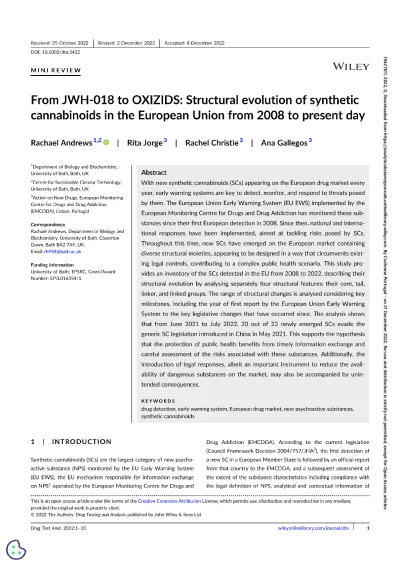Summary
This study provides an inventory of the SCs detected in the EU from 2008-2022, describing their structural evolution by analysing separately four structural features: their core, tail, linker, and linked groups. The range of structural changes is analysed considering key mile-stones, including the year of first report by the EU EWS, to the key legislative changes that have occurred since. The analysis shows that from June 2021 to July 2022, 20 out of 23 newly emerged SCs evade the generic SC legislation introduced in China in May 2021. This supports the hypothesis that the protection of public health benefits from timely information exchange and careful assessment of the risks associated with these substances. Additionally, the introduction of legal responses, albeit an important instrument to reduce the availability of dangerous substances on the market, may also be accompanied by unintended consequences.
Download as PDF
Paper as submitted
PDF files are made available as a convenience. In cases where the EMCDDA is not the originator of the document, please be aware that any PDFs available on this page may not be authoritative or there may be more recent versions available. While we make every effort to ensure that these files are definitive, before using or citing them, we recommend that you consult the publisher's website or contact the author(s) to check for more recent versions.
Abstract
With new synthetic cannabinoids (SC) appearing on the European drug market every year, early warning systems are key to detect, monitor, and respond to threats posed by them. The European Union Early Warning System (EU EWS) implemented by the European Monitoring Centre for Drugs and Drug Addiction has monitored these substances since their first European detection in 2008. Since then, national, and international responses have been implemented, aimed at tackling risks posed by SCs. Throughout this time, new SCs have emerged on the European market containing diverse structural moieties, appearing to be designed in a way that circumvents existing legal controls, contributing to a complex public health scenario. This study provides an inventory of the SCs detected in the EU from 2008-2022, describing their structural evolution by analysing separately four structural features: their core, tail, linker, and linked groups. The range of structural changes is analysed considering key milestones, including the year of first report by the EU EWS, to the key legislative changes that have occurred since. The analysis shows that from June 2021 to July 2022, 20 out of 23 newly emerged SCs evade the generic SC legislation introduced in China in May 2021. This supports the hypothesis that the protection of public health benefits from timely information exchange and careful assessment of the risks associated with these substances. Additionally, the introduction of legal responses, albeit an important instrument to reduce the availability of dangerous substances on the market, may also be accompanied by unintended consequences.









